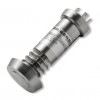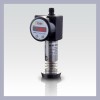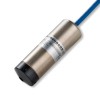High temperature protected sensors and instruments for taking measurements of very hot liquid or gases.
These devices are designed to withstand high temperature process media and incorporate very high temperature tolerant components or are combined with a cooling assembly to protect the heat sensitive part of device.
 High Temperature Pressure Transmitters - High temperature pressure transmitters with a 4-20mA output, tolerant to high temperature applications such as steam, food processing & engine monitoring.
High Temperature Pressure Transmitters - High temperature pressure transmitters with a 4-20mA output, tolerant to high temperature applications such as steam, food processing & engine monitoring. High Temperature Pressure Gauges - Pressure gauges for measuring high temperature fluids or gases. These high temperature pressure gauges are have or include optional extra design features to protect the pressure gauge from high temperature media.
High Temperature Pressure Gauges - Pressure gauges for measuring high temperature fluids or gases. These high temperature pressure gauges are have or include optional extra design features to protect the pressure gauge from high temperature media. High Temperature Liquid Level Sensors - Liquid level sensors with cooling elements for isolating a high media temperature or where the whole device can be submerged in a hot fluid.
High Temperature Liquid Level Sensors - Liquid level sensors with cooling elements for isolating a high media temperature or where the whole device can be submerged in a hot fluid.
Related Help Guides
- Understanding operating temperature limit specifications for pressure transducers
- Measuring the Pressure of Hot Media
Related Technical Terms
Questions & Answers
Temperature stand-off pipe
What does it mean by “If its just process temperature, you should be able to reduce the temperature acting on the sensor significantly using a short length of stainless steel or copper pipework”?
Also called the ‘stand-off pipe’ or ‘impulse line’ method, it makes use of the difference between the cooler ambient air and the high process temperature, since the sensor is dead-ended, the process media will cool along the pipe. Also mounting the sensor upside down with the pipe running up from the sensor can help as well.
Other methods to consider using are Pig-Tails, U-tubes, which are all designed to cause a temperature drop between the process and the measurement instrumentation, and are much lower cost than what you would pay for a sensor with a built-in high temperature capability.
